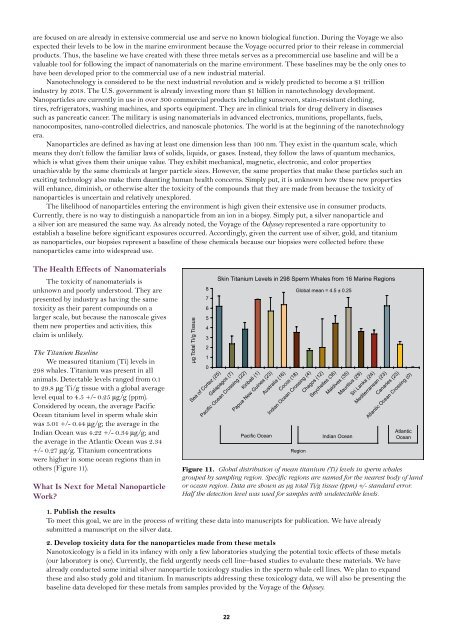Voyage of the Odyssey executive summary - Ocean Alliance
Voyage of the Odyssey executive summary - Ocean Alliance
Voyage of the Odyssey executive summary - Ocean Alliance
Create successful ePaper yourself
Turn your PDF publications into a flip-book with our unique Google optimized e-Paper software.
are focused on are already in extensive commercial use and serve no known biological function. During <strong>the</strong> <strong>Voyage</strong> we also<br />
expected <strong>the</strong>ir levels to be low in <strong>the</strong> marine environment because <strong>the</strong> <strong>Voyage</strong> occurred prior to <strong>the</strong>ir release in commercial<br />
products. Thus, <strong>the</strong> baseline we have created with <strong>the</strong>se three metals serves as a precommercial use baseline and will be a<br />
valuable tool for following <strong>the</strong> impact <strong>of</strong> nanomaterials on <strong>the</strong> marine environment. These baselines may be <strong>the</strong> only ones to<br />
have been developed prior to <strong>the</strong> commercial use <strong>of</strong> a new industrial material.<br />
Nanotechnology is considered to be <strong>the</strong> next industrial revolution and is widely predicted to become a $1 trillion<br />
industry by 2018. The U.S. government is already investing more than $1 billion in nanotechnology development.<br />
Nanoparticles are currently in use in over 300 commercial products including sunscreen, stain-resistant clothing,<br />
tires, refrigerators, washing machines, and sports equipment. They are in clinical trials for drug delivery in diseases<br />
such as pancreatic cancer. The military is using nanomaterials in advanced electronics, munitions, propellants, fuels,<br />
nanocomposites, nano-controlled dielectrics, and nanoscale photonics. The world is at <strong>the</strong> beginning <strong>of</strong> <strong>the</strong> nanotechnology<br />
era.<br />
Nanoparticles are defined as having at least one dimension less than 100 nm. They exist in <strong>the</strong> quantum scale, which<br />
means <strong>the</strong>y don’t follow <strong>the</strong> familiar laws <strong>of</strong> solids, liquids, or gases. Instead, <strong>the</strong>y follow <strong>the</strong> laws <strong>of</strong> quantum mechanics,<br />
which is what gives <strong>the</strong>m <strong>the</strong>ir unique value. They exhibit mechanical, magnetic, electronic, and color properties<br />
unachievable by <strong>the</strong> same chemicals at larger particle sizes. However, <strong>the</strong> same properties that make <strong>the</strong>se particles such an<br />
exciting technology also make <strong>the</strong>m daunting human health concerns. Simply put, it is unknown how <strong>the</strong>se new properties<br />
will enhance, diminish, or o<strong>the</strong>rwise alter <strong>the</strong> toxicity <strong>of</strong> <strong>the</strong> compounds that <strong>the</strong>y are made from because <strong>the</strong> toxicity <strong>of</strong><br />
nanoparticles is uncertain and relatively unexplored.<br />
The likelihood <strong>of</strong> nanoparticles entering <strong>the</strong> environment is high given <strong>the</strong>ir extensive use in consumer products.<br />
Currently, <strong>the</strong>re is no way to distinguish a nanoparticle from an ion in a biopsy. Simply put, a silver nanoparticle and<br />
a silver ion are measured <strong>the</strong> same way. As already noted, <strong>the</strong> <strong>Voyage</strong> <strong>of</strong> <strong>the</strong> <strong>Odyssey</strong> represented a rare opportunity to<br />
establish a baseline before significant exposures occurred. Accordingly, given <strong>the</strong> current use <strong>of</strong> silver, gold, and titanium<br />
as nanoparticles, our biopsies represent a baseline <strong>of</strong> <strong>the</strong>se chemicals because our biopsies were collected before <strong>the</strong>se<br />
nanoparticles came into widespread use.<br />
The Health Effects <strong>of</strong> Nanomaterials<br />
The toxicity <strong>of</strong> nanomaterials is<br />
unknown and poorly understood. They are<br />
presented by industry as having <strong>the</strong> same<br />
toxicity as <strong>the</strong>ir parent compounds on a<br />
larger scale, but because <strong>the</strong> nanoscale gives<br />
<strong>the</strong>m new properties and activities, this<br />
claim is unlikely.<br />
The Titanium Baseline<br />
We measured titanium (Ti) levels in<br />
298 whales. Titanium was present in all<br />
animals. Detectable levels ranged from 0.1<br />
to 29.8 μg Ti/g tissue with a global average<br />
level equal to 4.5 +/- 0.25 μg/g (ppm).<br />
Considered by ocean, <strong>the</strong> average Pacific<br />
<strong>Ocean</strong> titanium level in sperm whale skin<br />
was 5.01 +/- 0.44 μg/g; <strong>the</strong> average in <strong>the</strong><br />
Indian <strong>Ocean</strong> was 4.22 +/- 0.34 μg/g; and<br />
<strong>the</strong> average in <strong>the</strong> Atlantic <strong>Ocean</strong> was 2.34<br />
+/- 0.27 μg/g. Titanium concentrations<br />
were higher in some ocean regions than in<br />
o<strong>the</strong>rs (Figure 11).<br />
What Is Next for Metal Nanoparticle<br />
Work?<br />
µg Total Ti/g Tissue<br />
Skin Titanium Levels in 298 Sperm Whales from 16 Marine Regions<br />
8 Global mean = 4.5 ± 0.25<br />
7<br />
6<br />
5<br />
4<br />
3<br />
2<br />
1<br />
0<br />
1. Publish <strong>the</strong> results<br />
To meet this goal, we are in <strong>the</strong> process <strong>of</strong> writing <strong>the</strong>se data into manuscripts for publication. We have already<br />
submitted a manuscript on <strong>the</strong> silver data.<br />
2. Develop toxicity data for <strong>the</strong> nanoparticles made from <strong>the</strong>se metals<br />
Nanotoxicology is a field in its infancy with only a few laboratories studying <strong>the</strong> potential toxic effects <strong>of</strong> <strong>the</strong>se metals<br />
(our laboratory is one). Currently, <strong>the</strong> field urgently needs cell line–based studies to evaluate <strong>the</strong>se materials. We have<br />
already conducted some initial silver nanoparticle toxicology studies in <strong>the</strong> sperm whale cell lines. We plan to expand<br />
<strong>the</strong>se and also study gold and titanium. In manuscripts addressing <strong>the</strong>se toxicology data, we will also be presenting <strong>the</strong><br />
baseline data developed for <strong>the</strong>se metals from samples provided by <strong>the</strong> <strong>Voyage</strong> <strong>of</strong> <strong>the</strong> <strong>Odyssey</strong>.<br />
22<br />
Sea <strong>of</strong> Cortez (25)<br />
Galapagos (7)<br />
Pacific <strong>Ocean</strong> Crossing (22)<br />
Kiribati (1)<br />
Papua New Guinea (23)<br />
Australia (16)<br />
Cocos (18)<br />
Indian <strong>Ocean</strong> Crossing (4)<br />
Chagos (12)<br />
Seychelles (36)<br />
Maldives (35)<br />
Mauritius (29)<br />
Sri Lanka (24)<br />
Mediterranean (23)<br />
Canaries (23)<br />
Atlantic <strong>Ocean</strong> Crossing (0)<br />
Pacific <strong>Ocean</strong> Indian <strong>Ocean</strong><br />
Region<br />
Atlantic<br />
<strong>Ocean</strong><br />
Figure 11. Global distribution <strong>of</strong> mean titanium (Ti) levels in sperm whales<br />
grouped by sampling region. Specific regions are named for <strong>the</strong> nearest body <strong>of</strong> land<br />
or ocean region. Data are shown as µg total Ti/g tissue (ppm) +/- standard error.<br />
Half <strong>the</strong> detection level was used for samples with undetectable levels.


